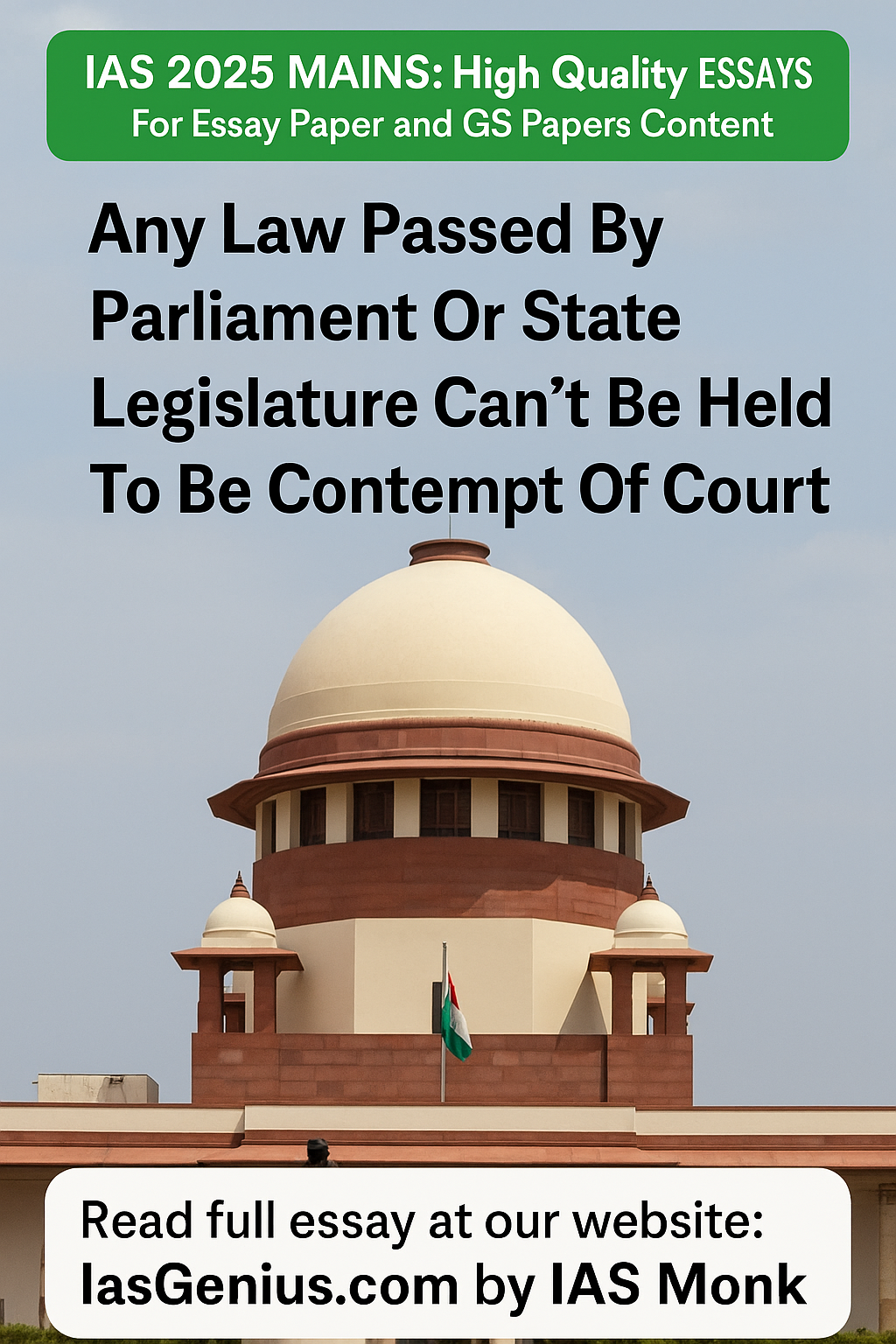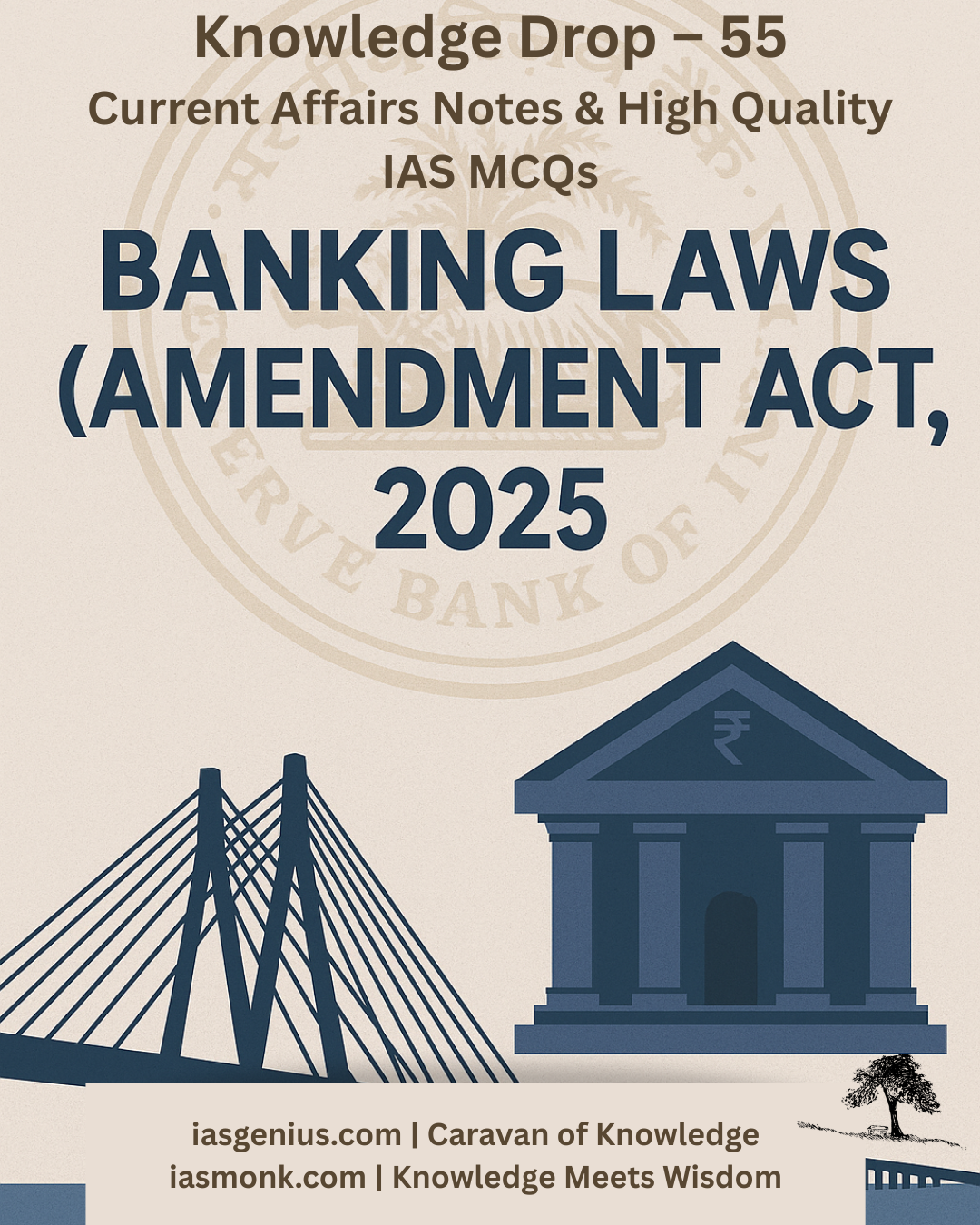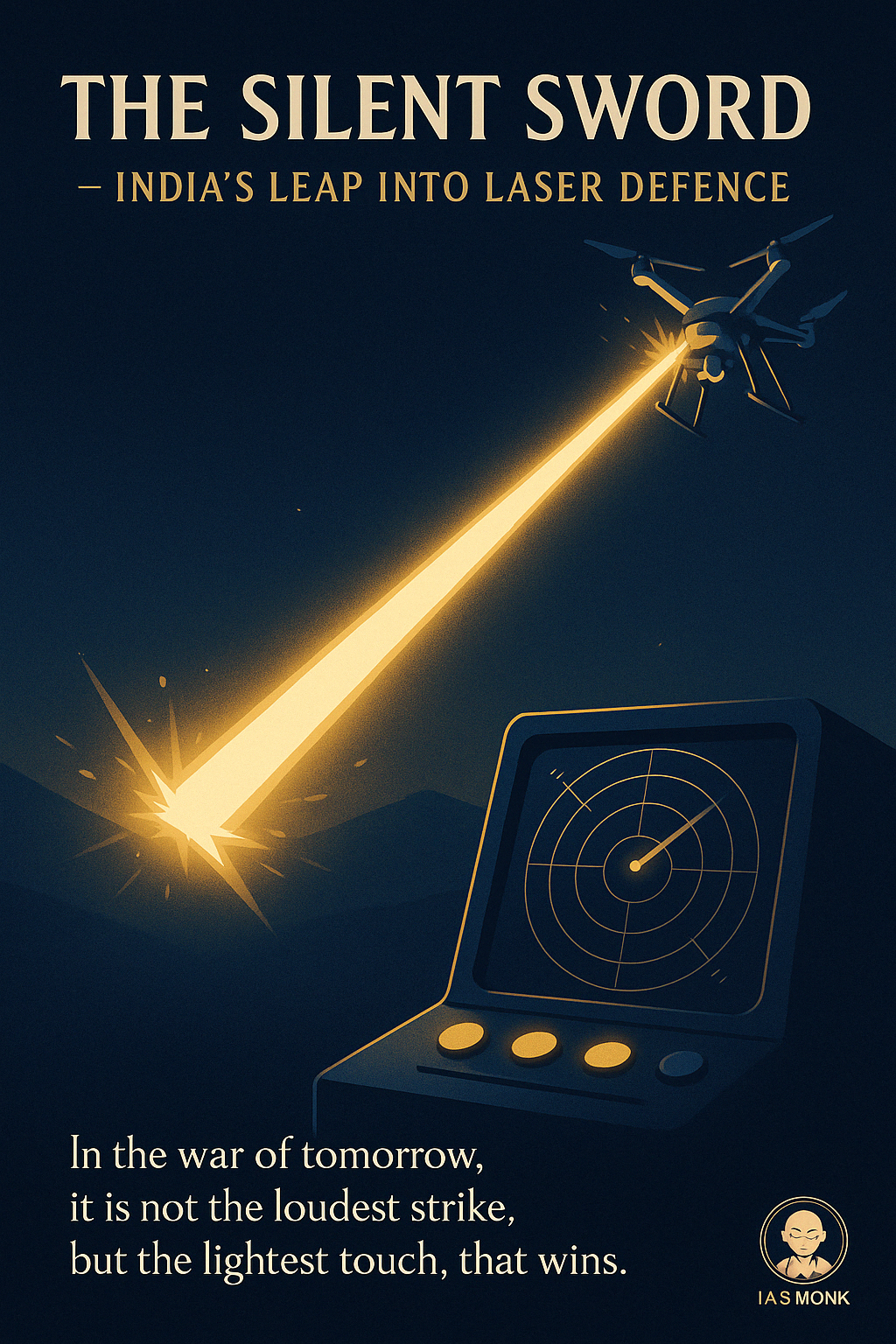
🧭June 5, 2025 Post 3: ⚖️ Laws vs Contempt: SC Clarifies the Boundary of Legislative Power | High Quality Mains Essay | Prelims MCQs
⚖️ Laws vs Contempt: SC Clarifies the Boundary of Legislative Power

POLITY – PETAL 003
Focus: GS2 – Judiciary | Separation of Powers | Constitutional Law
🧭 Intro Whisper
Can a legislature be held in contempt of court for enacting a new law? The Supreme Court answers: No — reinforcing the equilibrium between democracy and judicial oversight.
🏛️ What Did the Supreme Court Say?
- In closing the long-pending 2007 Salwa Judum case, the SC clarified a key constitutional principle:
“No law passed by Parliament or State Legislature can be treated as contempt of court merely because it disagrees with a previous ruling.”
- Legislative Supremacy:
✔️ Every legislature has plenary powers to enact laws.
✔️ These laws enjoy full legal force unless declared unconstitutional by a competent court. - Amendment is Not Contempt:
✔️ Legislatures can pass laws nullifying the basis of a judgment (without reversing the judgment).
✔️ They may also reframe laws that were struck down, aligning them with constitutional standards. - This reflects the doctrine of separation of powers: Judiciary interprets, Legislature legislates, and Executive implements.
🧾 Understanding Contempt of Court
| Type | Description |
|---|---|
| 🧑⚖️ Civil Contempt | Disobeying court orders or undertakings. |
| 👩⚖️ Criminal Contempt | Scandalising the court, prejudicing a trial, or obstructing justice. |
- Article 129: SC can punish for contempt as a court of record.
- Article 215: High Courts enjoy similar powers.
- Contempt of Courts Act, 1971: Codifies procedures and definitions.
- Article 142(2): Empowers SC to frame contempt procedures, subject to laws made by Parliament.
🚨 Controversies & Safeguards
- Freedom of Expression (Article 19(1)(a)) often clashes with contempt powers.
- Critics argue the term “scandalising the court” is vague and prone to misuse.
- Truth + Public Interest is now a defence (since 2006 amendment).
- Countries like the UK have abolished criminal contempt laws altogether.
📘 Case Connect: The Salwa Judum Judgment
- In Nandini Sundar vs State of Chhattisgarh (2011), SC declared the Salwa Judum anti-Naxal militia as unconstitutional.
- Ruled:
🔺 State cannot arm civilians as vigilantes
🔺 Appointment of tribal SPOs violated Article 21 (Right to Life)
🔺 Ordered investigation, compensation & tribal rehabilitation - The case now officially closes, with a broader judicial remark on legislative powers and contempt law.
What is Slawa Judum Case?
The Salwa Judum case refers to a significant legal and human rights issue related to a controversial anti-Maoist militia in Chhattisgarh, India. Here’s a brief overview:
Background:
- Salwa Judum (meaning “Peace March” in Gondi language) was a state-sponsored armed movement launched in 2005 in Chhattisgarh to counter Naxalite (Maoist) insurgents.
- It involved arming local tribal youth as Special Police Officers (SPOs) to fight Maoists, leading to allegations of human rights abuses, including killings, arson, and forced displacement of tribal communities.
Supreme Court Judgment (2011):
- In Nandini Sundar & Others vs. State of Chhattisgarh (2011), the Supreme Court of India declared Salwa Judum illegal and unconstitutional.
- The court ruled that:
- The state cannot arm civilians to fight insurgents, as it violates the Rule of Law and right to life (Article 21).
- The appointment of SPOs (mostly tribal youth) with weapons was unlawful.
- The state must investigate and prosecute Salwa Judum members involved in violence.
- The government must rehabilitate displaced tribals affected by the conflict.
Aftermath:
- The judgment was a major setback for the Chhattisgarh government’s counter-insurgency strategy.
- However, Salwa Judum’s disbandment did not fully end vigilante violence, and some former members allegedly merged into other state-backed forces like the District Reserve Guards (DRG).
Human Rights Concerns:
- Salwa Judum was accused of extrajudicial killings, sexual violence, and burning villages, forcing thousands to flee.
- Maoists also committed atrocities, leading to a cycle of violence in the region.
Significance:
The case highlighted the dangers of state-sponsored vigilantism and reinforced constitutional safeguards against arming civilians in conflict zones.
🧭 GS Mains Mapping
| GS Paper | Area | Subtopics |
|---|---|---|
| GS2 | Polity & Constitution | Contempt of Court, Legislative Powers, Separation of Powers |
| GS2 | Governance | Judiciary-Legislature Relations |
| GS4 | Ethics in Public Life | Institutional Integrity, Constitutional Morality |
🪔 A Thought Spark — by IAS Monk
“A democracy thrives when its pillars speak to each other — not over each other. A law may contradict a ruling, but contempt is silence, not debate.”
High Quality Mains Essay For Practice :
Word Limit 1000-1200
🟩 IAS 2025 MAINS: High Quality ESSAYS For Essay Paper and GS Papers Content
Contempt, Constitution and Legislative Authority: Rebalancing Powers in a Democracy
Introduction
In a constitutional democracy, the separation of powers among the legislature, executive, and judiciary forms the bedrock of governance. The recent Supreme Court observation—made while closing the long-standing Salwa Judum case—that no law passed by Parliament or a State Legislature can be deemed contempt of court, reaffirms this fundamental tenet. This essay explores the doctrine of contempt in the Indian context, its constitutional scope, and the limits of judicial review over legislative functioning. At its heart, the issue underscores the necessity of balance: ensuring that the judiciary remains respected and independent, while the legislature retains its sovereign law-making power.
Understanding the Contempt Power
Contempt of court is a legal mechanism meant to uphold the dignity, authority, and effectiveness of the judicial system. It is of two types:
- Civil Contempt: Willful disobedience of any court judgment, order, or direction.
- Criminal Contempt: Any publication or act that scandalizes the court, lowers its authority, or obstructs judicial proceedings.
The Constitutional and Statutory backing for contempt includes:
- Article 129: Supreme Court is a court of record with the power to punish for contempt.
- Article 215: High Courts also enjoy similar contempt powers.
- Contempt of Courts Act, 1971: Defines the scope and limitations of contempt.
- Article 142(2): Empowers the SC to punish for its own contempt.
While these provisions are designed to protect the sanctity of justice, they also carry the risk of stifling legitimate criticism or democratic processes when applied without restraint.
The Legislative Power to Make Law
The Constitution vests plenary powers of legislation in elected bodies:
- Article 245 and 246 empower Parliament and State Legislatures to make laws on subjects enumerated in the Union, State, and Concurrent Lists.
- So long as a law is within the legislative competence and does not violate constitutional provisions, it holds the force of law—even if it alters the effect or context of a judicial ruling.
This is particularly important in a dynamic socio-political environment, where laws must adapt to new realities. Legislative amendments are often a response to judicial interpretation, helping bridge gaps or clarify ambiguities.
Supreme Court’s Clarification in 2024
In its observation made during the closure of the Salwa Judum case, the Supreme Court stated:
“Any law made by Parliament or a State Legislature cannot be treated as contempt of court merely because it alters or overcomes the effect of a judicial ruling.”
The Court emphasized that legislatures are free to amend laws or nullify the basis of a judgment—as long as they do not overrule the judgment itself. This nuance is crucial.
For instance:
- A Supreme Court verdict may invalidate a law due to lack of procedural safeguards.
- The Legislature can then reintroduce the law with modifications addressing those concerns—without violating judicial authority.
Such a framework ensures democratic resilience, allowing different arms of the state to respond to each other while remaining constitutionally compliant.
Contempt vs Constitutional Challenge
There is a key difference between:
- Contempt of court, which penalizes acts that disrespect or disrupt judicial authority.
- And challenging or reversing a judgment through a valid legislative mechanism, which is part of the constitutional process.
For example, the Supreme Court struck down the NJAC (National Judicial Appointments Commission) Act in 2015 as unconstitutional. However, if Parliament seeks to reintroduce judicial reforms by revisiting the constitutional amendment route, it is not contempt, but a legitimate exercise of its constituent power.
Similarly, in Indira Nehru Gandhi vs Raj Narain, the 39th Constitutional Amendment was struck down for violating the basic structure. Yet, Parliament was not held in contempt—it was merely checked under the doctrine of judicial review.
Contempt and Freedom of Speech
One of the biggest criticisms of the contempt law in India is its potential conflict with Article 19(1)(a) — the right to freedom of speech and expression.
- Criminal contempt, particularly the clause about “scandalizing the court,” has often been labelled vague and subjective.
- The 2006 amendment to the Contempt of Courts Act added truth as a defence, but only when it is in public interest and made in good faith.
- Even so, constructive criticism of judicial rulings must not be mistaken for contempt.
In countries like the United Kingdom, criminal contempt for scandalizing the court has been abolished. The UK Law Commission deemed it obsolete and incompatible with free speech. India must eventually move in this direction by redefining the boundaries of contempt more precisely.
The Salwa Judum Case: Constitutional Lessons
The Salwa Judum case itself represents a powerful instance of judicial intervention in defence of human rights and constitutional morality.
- Launched in 2005 in Chhattisgarh, Salwa Judum was a state-sponsored counterinsurgency militia.
- It involved arming tribal youth as Special Police Officers (SPOs) to fight Maoist insurgents.
- In 2011, the Supreme Court ruled that:
- The government cannot arm civilians to fight insurgents.
- It violated Article 21 (Right to Life) and the Rule of Law.
- Directed disbanding of Salwa Judum and rehabilitation of displaced tribals.
Now, in 2024, as the case closed, the Court clarified that even if legislatures choose to enact new laws in this domain, they cannot be automatically construed as being in contempt of court. This distinction preserves the integrity of both judicial directions and legislative autonomy.
Checks and Balances: How Should the System Work?
India’s Constitution ensures that no organ of the state is absolute:
| Institution | Role | Check |
|---|---|---|
| Legislature | Makes laws | Judicial review |
| Judiciary | Interprets laws | Subject to Constitutional limits |
| Executive | Implements laws | Accountable to Legislature and Judiciary |
When the judiciary strikes down a law, it does not make the legislature impotent. Instead, it invites reform through reasoned amendments or re-enactments. That is dialogue, not defiance.
Similarly, the judiciary can use contempt powers to ensure compliance—but not to throttle parliamentary will expressed through proper constitutional channels.
GS Mains Mapping
| GS Paper | Theme | Subtopics |
|---|---|---|
| GS2 | Polity & Constitution | Contempt of Court, Separation of Powers, Article 129, 142 |
| GS2 | Governance & Judiciary | Salwa Judum, Rule of Law, Human Rights |
| GS4 | Ethics in Public Life | Institutional Balance, Rule of Law, Constitutional Morality |
Conclusion: The Future of Institutional Dialogue
Democracy is not the absence of tension between institutions — it is their constant negotiation within constitutional boundaries. The Supreme Court’s recent clarification ensures that legislative creativity and corrective governance are not seen as judicial insults. It respects the plural voice of a democratic state.
Going forward, reforms in the contempt law are also essential. The aim must be to protect the sanctity of justice, not the fragility of egos. A mature judiciary, a responsible legislature, and an empowered citizenry together safeguard the constitutional promise.
In the Indian model, the question is not who rules, but how well the rules are respected by all. True harmony lies not in silencing the other, but in listening — and legislating — with constitutional fidelity.
Target IAS-26: Daily MCQs :
📌 Prelims Practice MCQs
Topic:
MCQ 1 – Type 1: How many of the above statements are correct?
Consider the following statements regarding the powers of Parliament in relation to judicial rulings:
1. Parliament can pass a new law to override a Supreme Court judgment if it believes the judgment affects national interest.
2. Any such law will automatically be considered contempt of court unless pre-approved by the judiciary.
3. The legislature has the power to nullify the basis of a judicial judgment, not the judgment itself.
4. Laws passed by the legislature cannot be held invalid unless declared unconstitutional by a constitutional court.
How many of the above statements are correct?
A) Only two
B) Only three
C) All four
D) Only one
🌀 Didn’t get it? Click here (▸) for the Correct Answer & Explanation
✅ Correct Answer: B) Only three
🧠 Explanation:
•1) ✅ True – Parliament can pass laws that alter the basis of a judgment if done within constitutional bounds.
•2) ❌ False – No law is automatically contempt; it must be challenged and ruled unconstitutional to be void.
•3) ✅ True – Legislatures may neutralize the basis of a ruling but not override the verdict itself.
•4) ✅ True – Laws remain valid unless declared unconstitutional by courts.
MCQ 2 – Type 2: Two Statements Based
Consider the following two statements:
1. Article 129 empowers the High Courts to punish for their own contempt.
2. Article 142(2) grants the Supreme Court powers to punish for contempt, subject to law made by Parliament.
Which of the above statements is/are correct?
A) Only 1 is correct
B) Only 2 is correct
C) Both are correct
D) Neither is correct
🌀 Didn’t get it? Click here (▸) for the Correct Answer & Explanation
✅ Correct Answer: B) Only 2 is correct
🧠 Explanation:
•1) ❌ False – Article 129 applies to the Supreme Court. High Courts derive contempt powers from Article 215.
•2) ✅ True – Article 142(2) allows the Supreme Court to punish for contempt, but this is subject to law made by Parliament (e.g., the Contempt of Courts Act, 1971).
MCQ 3 – Type 3: Which of the statements is/are correct?
Which of the following are correct regarding the 2011 Salwa Judum case judgment?
1. The Supreme Court upheld the practice of arming tribal youth as Special Police Officers.
2. The judgment emphasized protection of tribal rights under Article 21 of the Constitution.
3. The SC directed the rehabilitation of displaced tribal families affected by the conflict.
Select the correct code:
A) 1 and 2 only
B) 2 and 3 only
C) 1 and 3 only
D) All of the above
🌀 Didn’t get it? Click here (▸) for the Correct Answer & Explanation
✅ Correct Answer: B) 2 and 3 only
🧠 Explanation:
•1) ❌ False – The SC declared the arming of civilians unconstitutional.
•2) ✅ True – The right to life and dignity was a central pillar in the judgment.
•3) ✅ True – The court directed the government to ensure proper rehabilitation of affected persons.
MCQ 4 – Type 4: Direct Fact
Which of the following Articles of the Constitution designates the Supreme Court as a “Court of Record” with the power to punish for contempt?
A) Article 136
B) Article 142
C) Article 129
D) Article 226
🌀 Didn’t get it? Click here (▸) for the Correct Answer & Explanation.
✅ Correct Answer: C) Article 129
🧠 Explanation:
•Article 129 of the Indian Constitution declares the Supreme Court to be a court of record with powers to punish for its own contempt.
•Article 215 provides similar powers to High Courts.
•Article 136 pertains to special leave to appeal, and Article 226 relates to writ jurisdiction of High Courts.


















